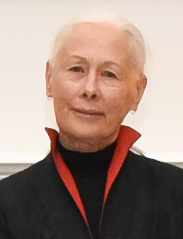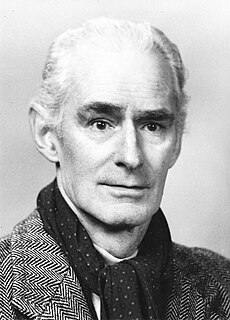Marianne Muggeridge | |
|---|---|
 | |
| Born | 1952 (age 69–70) Hamilton, New Zealand |
Marianne Muggeridge (born 1952) is a New Zealand painter and screenprinter based in Taranaki. She is best known for portraits of notable New Zealanders, cityscapes and landscapes.
Marianne Muggeridge | |
|---|---|
 | |
| Born | 1952 (age 69–70) Hamilton, New Zealand |
Marianne Muggeridge (born 1952) is a New Zealand painter and screenprinter based in Taranaki. She is best known for portraits of notable New Zealanders, cityscapes and landscapes.
Muggeridge was born in Hamilton, New Zealand in 1952. As a child, her family moved to Taranaki, where they lived in Alton, Ōpunake and New Plymouth. [1] She is of English and Irish ancestry. [2]
Muggeridge attended Spotswood College in New Plymouth and later Elam School of Fine Arts in Auckland, where she completed a Bachelor of Fine Arts in 1973. [1]
From the early 1970s Muggeridge lived outside New Zealand, [3] including in Paris, Wales and London. [1] In 1985 she held an exhibition at New Zealand House. [1]
In 2000, Muggeridge returned to New Zealand, settling in Wellington where she learned screenprinting from Michael Smither. [3] She won the first New Zealand Portrait Gallery Adam Portraiture award in 2000 for Lucy in her Green Dress [4] and again in 2002 for Meren and Josie, [5] receiving commendations in the contest in a further five years. [6]
Muggeridge's success in the Adam Portraiture Award led to commissions to paint portraits of notable New Zealanders, including Don Brash for Reserve Bank of New Zealand, [7] Professor Alan MacDiarmid and Sir Paul Callaghan for the Royal Society of New Zealand [8] and Professors James McWha and Judith Kinnear for Massey University. [9]
In 2011, she returned to live and work in Taranaki. [10]
In 2013, the New Zealand Portrait Gallery held a major retrospective of Muggeridge's work, including some 50 nudes, portraits of individuals and groups, and landscapes. [10]
Muggeridge's work is in the collections of many notable New Zealand Institutions, including Museum of New Zealand Te Papa Tongarewa, [11] Taranaki's Puke Ariki [12] and the New Zealand Portrait Gallery. [13]
Muggeridge's style is described as realist. [14] She prefers to paint from life. [9] She says her paintings of people often involve multiple sittings, and some have taken up to four years to complete. She also speaks of the importance of the relationship between the artist and the sitter in portraiture, [10] using colour and shadow in landscape painting and when painting a nude, attention to skin tones. [15]
Muggeridge says she changes between landscapes and portraits because changing between the two can bring about feelings of relief or stimulation. [15] She has used a freezer to keep oil paint wet between sittings. [15]

Rita Angus, a New Zealand painter, has a reputation - along with Colin McCahon and Toss Woollaston - as one of the leading figures in twentieth-century New Zealand art. She worked primarily in oil and water colour, and became well-known for her portraits and landscapes.

Frances Mary Hodgkins was a New Zealand painter chiefly of landscape and still life, and for a short period was a designer of textiles. She was born and raised in New Zealand, but spent most of her working life in England. She is considered one of New Zealand's most prestigious and influential painters, although it is the work from her life in Europe, rather than her home country, on which her reputation rests.
Michael Duncan Smither is a New Zealand painter and composer.
Girolamo Pieri Pecci Ballati Nerli, was an Italian painter who worked and travelled in Australia and New Zealand in the late 19th century influencing Charles Conder and Frances Hodgkins and helping to move Australian and New Zealand art in new directions. His portrait of Robert Louis Stevenson in the Scottish National Portrait Gallery Edinburgh, is usually considered the most searching portrayal of the writer.

Sofia Minson is a contemporary New Zealand oil painter of Māori, Swedish, English and Irish descent.
Bryan Organ is a British artist considered one of the leading and most innovative English portrait painters of the 20th century. His paintings have included portraits of prominent public figures and of members of the British royal family. Organ is also known for landscape paintings, such as St Pancras Station,, and lithographic studies of animals (Tate). London's National Portrait Gallery holds a total of sixteen of his portraits of which six were commissioned by the Gallery's Trustees.

Puke Ariki is a combined museum and library at New Plymouth, New Zealand which opened in June 2003. It is an amalgamation of the New Plymouth Public Library and the Taranaki Museum. Its name, Māori for "hill of chiefs", is taken from the Māori village that formerly occupied the site.

Doris More Lusk was a New Zealand painter, potter, art teacher, and university lecturer. In 1990 she was posthumously awarded the Governor General Art Award in recognition of her artistic career and contributions.
Edith Stanway Halcombe was a New Zealand artist, community leader and farmer. She was born on 27 April 1844, the daughter of William John Swainson and his second wife, Anne Grasby. She was taught art by her father who was a competent artist in his own right. She married Arthur Halcombe on 3 December 1863 at St James' Church, Hutt.
Kohai Grace is a New Zealand weaver. Her iwi are Ngāti Toa Rangatira, Ngāti Porou, Te Āti Awa and Ngāti Raukawa.

Veranoa Angelique Hetet is a New Zealand Māori weaver and contemporary artist of Te Atiawa, Ngāti Tuwharetoa and Ngāti Maniapoto descent.

Dame Robin Adair White is a New Zealand painter and printmaker, recognised as a key figure in the regionalist movement of 20th-century New Zealand art.

Douglas Kerr MacDiarmid was a New Zealand expatriate painter, known for his diversity and exceptional use of colour, and involved with key movements in twentieth-century art. He lived in Paris, France, for most of his career.
Marian Maguire is a lithographer from New Zealand. She is known for juxtaposing landscapes, historical characters, and mythical figures from New Zealand and from ancient Greece, mixing the realism of 19th-century colonial prints with the more stylized designs of Greek black-figure pottery and Māori wood carvings.
Maude Burge was a New Zealand painter influenced by James Nairn. She spent time as an expatriate artist specifically in Europe. Burge was a painting companion of Frances Hodgkins who called Maude Burge a "charming changeable woman" in her published letters. They painted together at the Burge family home in St.Tropez and in Ibiza. Burge's paintings are held in the permanent collection of Auckland Art Gallery, the Museum of New Zealand Te Papa Tongarewa, the National Art Gallery of New Zealand, the Fletcher Trust Collection, the National Library of New Zealand and among private art collectors in the northern and southern hemispheres. Burge exhibited her paintings at the New Zealand Academy of Fine Arts.

Suzanne Goldberg (1940–1999) was a New Zealand painter, born in Auckland, New Zealand.
Eleanor 'Ella' Juliet Spicer was a New Zealand artist. Her work is included in the collection of the Museum of New Zealand Te Papa Tongarewa, Turnbull library and Hocken library.
Elizabeth Wallwork was a New Zealand artist.
Joan Ivory Dukes was a New Zealand artist and illustrator.